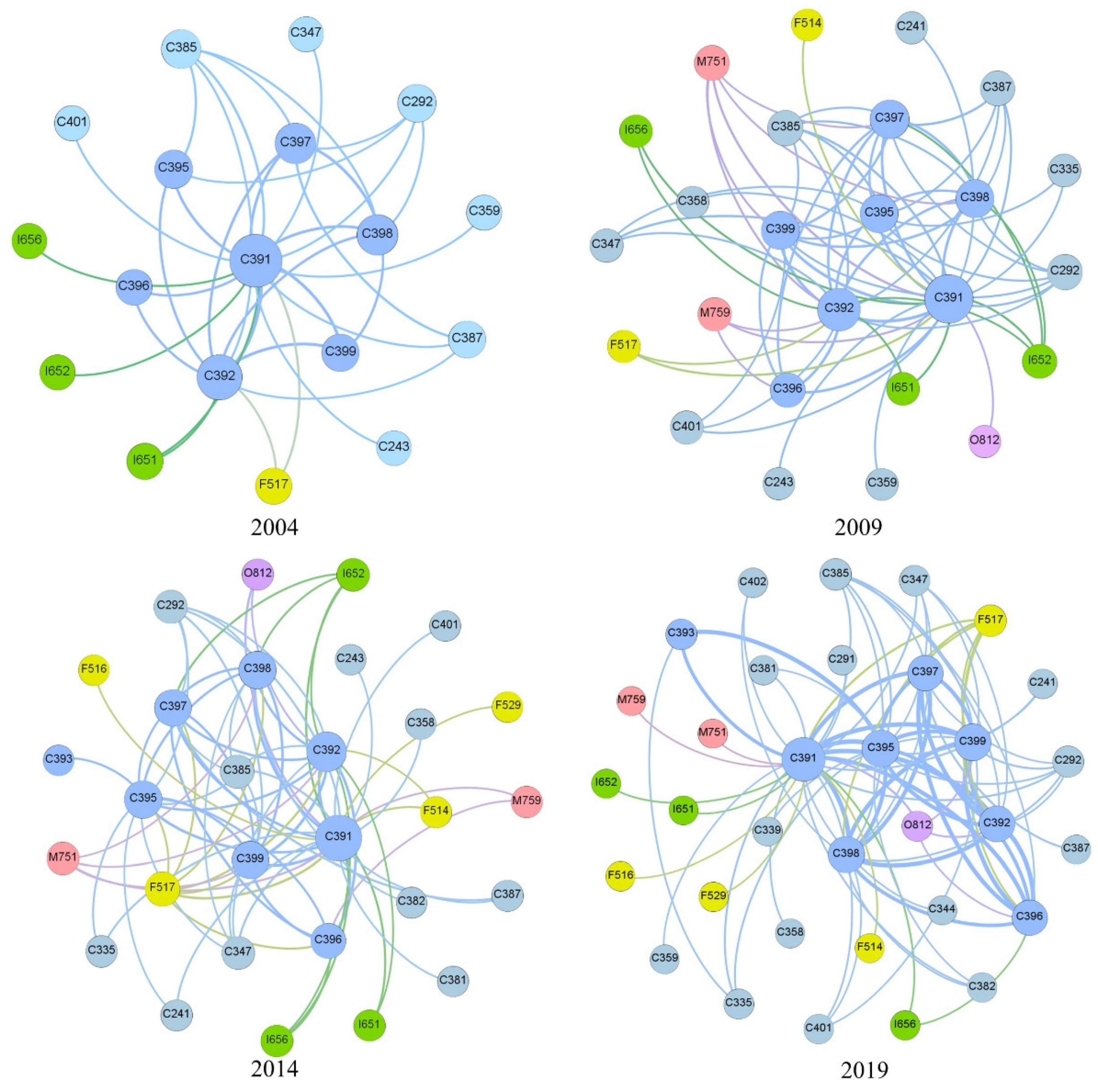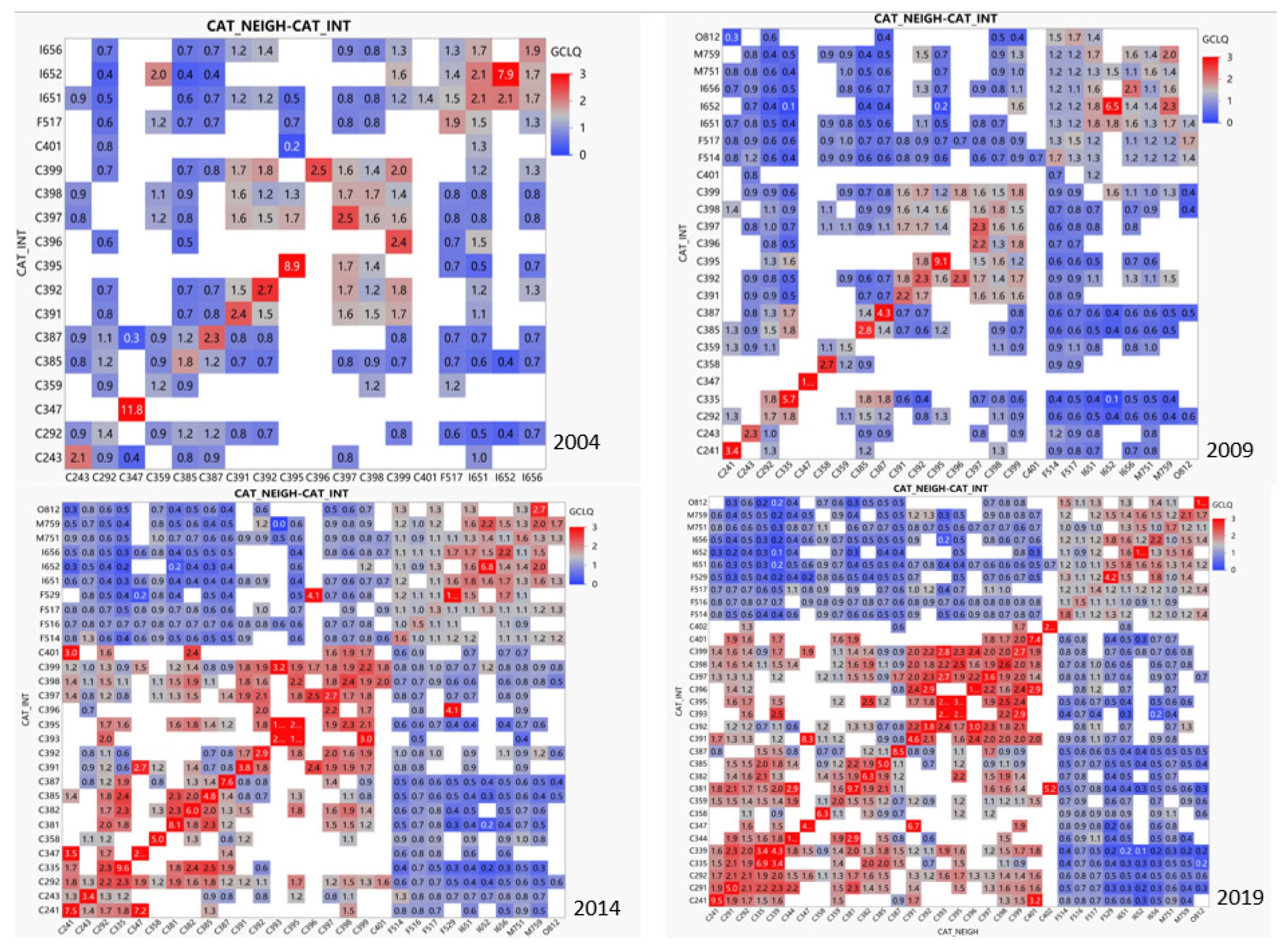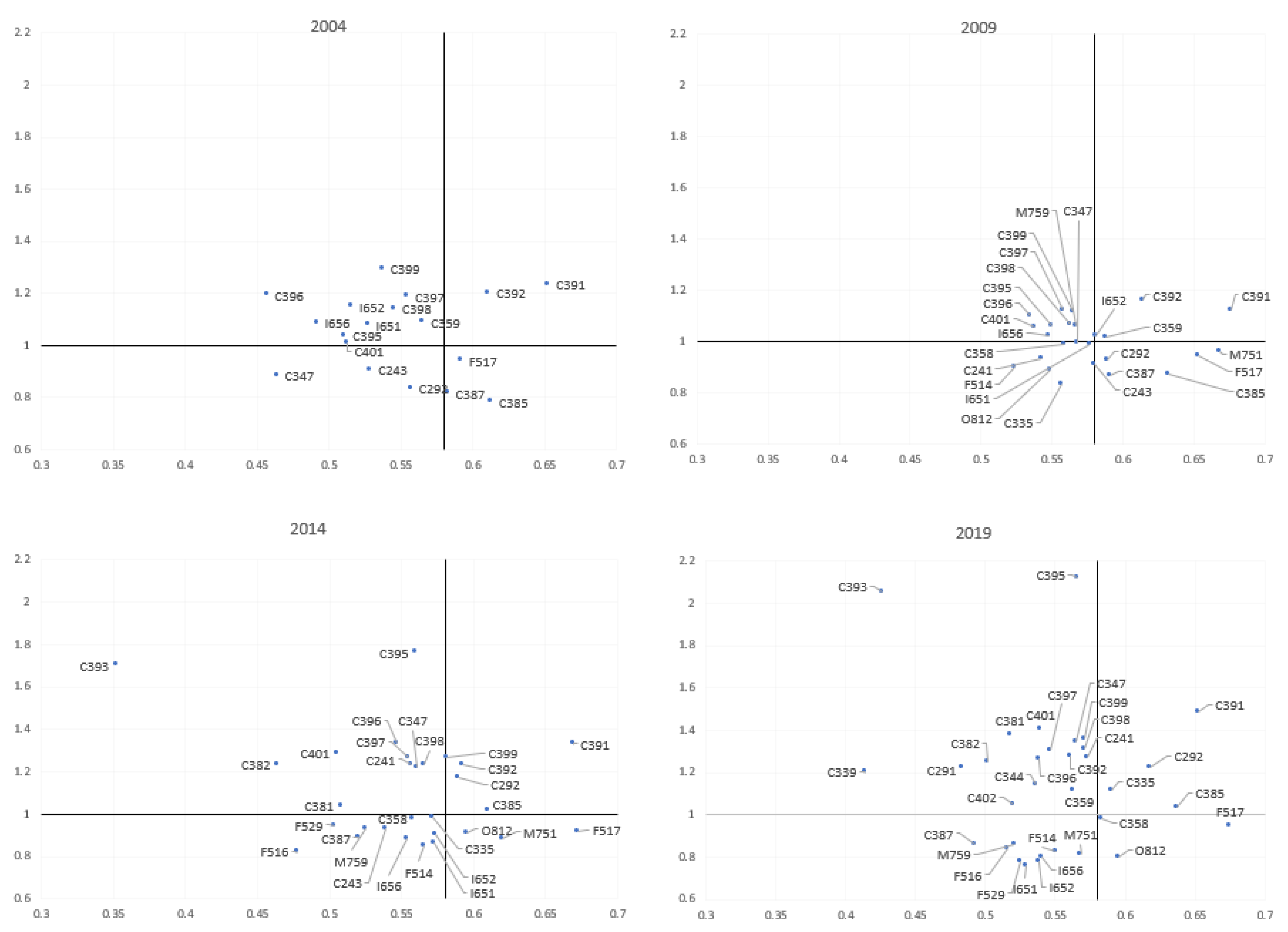Industry Linkage and Spatial Co-Evolution Characteristics of Industrial Clusters Based on Natural Semantics—Taking the Electronic Information Industry Cluster in the Pearl River Delta as an Example
Abstract
1. Introduction
2. Literature Review
3. Materials and Methods
3.1. Study Area
3.2. Data Source
3.3. Methodology
3.3.1. Term Frequency–Inverse Document Frequency (TF-IDF)
3.3.2. The Colocation Quotient (CLQ)
4. Results
4.1. Changes in Industrial Cluster Industry Linkage Network
4.2. Change in Spatial Synergy Characteristics of Industrial Clusters
4.3. Spatial Link Change Types of Industrial Clusters
5. Discussions and Conclusions
Author Contributions
Funding
Conflicts of Interest
References
- Van den Berg, L.; Braun, E.; Van Winden, W. Growth clusters in European cities: An integral approach. Urban Stud. 2001, 38, 185–205. [Google Scholar] [CrossRef]
- Bresnahan, T.; Gambardella, A. Building High-Tech Clusters: Silicon Valley and Beyond; Cambridge University Press: Cambridge, UK, 2004. [Google Scholar]
- Hirschman, A.O. The Strategy of Economic Development; Yale University Press: New Haven, CT, USA, 1958. [Google Scholar]
- Sadik-Zada, E.R.; Loewenstein, W.; Hasanli, Y. Production linkages and dynamic fiscal employment effects of the extractive industries: Input-output and nonlinear ARDL analyses of Azerbaijani economy. Miner. Econ. 2021, 34, 3–18. [Google Scholar] [CrossRef]
- Feldman, M.P.; Audretsch, D.B. Innovation in cities:: Science-based diversity, specialization and localized competition. Eur. Econ. Rev. 1999, 43, 409–429. [Google Scholar] [CrossRef]
- Porter, M. The economic performance of regions. Reg. Stud. 2003, 37, 549–578. [Google Scholar] [CrossRef]
- Henderson, V. Externalities and industrial development. J. Urban Econ. 1997, 42, 449–470. [Google Scholar] [CrossRef]
- Delgado, M.; Porter, M.E.; Stern, S. Clusters, convergence, and economic performance. Res. Policy 2014, 43, 1785–1799. [Google Scholar] [CrossRef]
- Yang, Z.; Sliuzas, R.; Cai, J.; Ottens, H.F. Exploring spatial evolution of economic clusters: A case study of Beijing. Int. J. Appl. Earth Obs. Geoinf. 2012, 19, 252–265. [Google Scholar] [CrossRef]
- Searle, G.; Sigler, T.; Martinus, K. Firm evolution and cluster specialization: A social network analysis of resource industry change in two Australian cities. Reg. Stud. Reg. Sci. 2018, 5, 369–387. [Google Scholar] [CrossRef]
- Carlino, G.A. Manufacturing agglomeration economies as returns to scale: A production function approach. Pap. Reg. Sci. Assoc. 1982, 50, 95–108. [Google Scholar] [CrossRef]
- Amin, A.; Thrift, N.J. Neo-Marshallian nodes in global networks. Int. J. Urban Reg. Res. 1992, 16, 571–587. [Google Scholar] [CrossRef]
- Kowalski, A.M.; Marcinkowski, A. Clusters versus cluster initiatives, with focus on the ICT sector in Poland. Eur. Plan. Stud. 2014, 22, 20–45. [Google Scholar] [CrossRef]
- Arbia, G.; Espa, G.; Giuliani, D.; Mazzitelli, A. Clusters of firms in an inhomogeneous space: The high-tech industries in Milan. Econ. Model. 2012, 29, 3–11. [Google Scholar] [CrossRef]
- Wen, M. Relocation and agglomeration of Chinese industry. J. Dev. Econ. 2004, 73, 329–347. [Google Scholar] [CrossRef]
- Long, C.; Zhang, X. Patterns of China’s industrialization: Concentration, specialization, and clustering. China Econ. Rev. 2012, 23, 593–612. [Google Scholar] [CrossRef]
- Behrens, K.; Bougna, T. An anatomy of the geographical concentration of Canadian manufacturing industries. Reg. Sci. Urban Econ. 2015, 51, 47–69. [Google Scholar] [CrossRef]
- Koh, H.-J.; Riedel, N. Assessing the localization pattern of German manufacturing and service industries: A distance-based approach. Reg. Stud. 2014, 48, 823–843. [Google Scholar] [CrossRef]
- Jaffe, A.B.; Trajtenberg, M.; Henderson, R. Geographic localization of knowledge spillovers as evidenced by patent citations. Q. J. Econ. 1993, 108, 577–598. [Google Scholar] [CrossRef]
- Dauth, W.; Fuchs, M.; Otto, A. Long-run processes of geographical concentration and dispersion: Evidence from Germany. Pap. Reg. Sci. 2018, 97, 569–593. [Google Scholar] [CrossRef]
- Turkina, E.; Van Assche, A.; Kali, R. Structure and evolution of global cluster networks: Evidence from the aerospace industry. J. Econ. Geogr. 2016, 16, 1211–1234. [Google Scholar] [CrossRef]
- He, C.; Wei, Y.D.; Pan, F. Geographical concentration of manufacturing industries in China: The importance of spatial and industrial scales. Eurasian Geogr. Econ. 2007, 48, 603–625. [Google Scholar] [CrossRef]
- Audretsch, D.B.; Feldman, M.P. R&D spillovers and the geography of innovation and production. Am. Econ. Rev. 1996, 86, 630–640. [Google Scholar]
- Maurel, F.; Sédillot, B. A measure of the geographic concentration in French manufacturing industries. Reg. Sci. Urban Econ. 1999, 29, 575–604. [Google Scholar] [CrossRef]
- Maskell, P.; Malmberg, A. Localised learning and industrial competitiveness. Camb. J. Econ. 1999, 23, 167–185. [Google Scholar] [CrossRef]
- Bathelt, H.; Malmberg, A.; Maskell, P. Clusters and knowledge: Local buzz, global pipelines and the process of knowledge creation. Prog. Hum. Geogr. 2004, 28, 31–56. [Google Scholar] [CrossRef]
- Owen-Smith, J.; Powell, W.W. Knowledge networks as channels and conduits: The effects of spillovers in the Boston biotechnology community. Organ. Sci. 2004, 15, 5–21. [Google Scholar] [CrossRef]
- Wolfe, D.A.; Gertler, M.S. Clusters from the inside and out: Local dynamics and global linkages. Urban Stud. 2004, 41, 1071–1093. [Google Scholar] [CrossRef]
- Lorenzen, M.; Mudambi, R. Clusters, connectivity and catch-up: Bollywood and Bangalore in the global economy. J. Econ. Geogr. 2013, 13, 501–534. [Google Scholar] [CrossRef]
- Spencer, G.M.; Vinodrai, T.; Gertler, M.S.; Wolfe, D.A. Do clusters make a difference? Defining and assessing their economic performance. Reg. Stud. 2010, 44, 697–715. [Google Scholar] [CrossRef]
- Porter, M.E. The competitive advonioge of notions. Harv. Bus. Rev. 1990, 73, 91. [Google Scholar]
- Swann, G.; Prevezer, M.; Stout, D. The Dynamics of Industrial Clustering: International Comparisons in Computing and Biotechnology; Oxford University Press: Oxford, UK, 1998. [Google Scholar]
- Schmitz, H.; Nadvi, K. Clustering and industrialization: Introduction. World Dev. 1999, 27, 1503–1514. [Google Scholar] [CrossRef]
- Morosini, P. Industrial clusters, knowledge integration and performance. World Dev. 2004, 32, 305–326. [Google Scholar] [CrossRef]
- Czamanski, S.; Ablas, L.A.d.Q. Identification of industrial clusters and complexes: A comparison of methods and findings. Urban Stud. 1979, 16, 61–80. [Google Scholar] [CrossRef]
- De Propris, L. Mapping local production systems in the UK: Methodology and application. Reg. Stud. 2005, 39, 197–211. [Google Scholar] [CrossRef]
- Rosenfeld, S.A. Bringing business clusters into the mainstream of economic development. Eur. Plan. Stud. 1997, 5, 3–23. [Google Scholar] [CrossRef]
- Guo, J.; Lao, X.; Shen, T. Location-based method to identify industrial clusters in Beijing-Tianjin-Hebei area in China. J. Urban Plan. Dev. 2019, 145, 04019001. [Google Scholar] [CrossRef]
- Liu, Z. Global and local: Measuring geographical concentration of China’s manufacturing industries. Prof. Geogr. 2014, 66, 284–297. [Google Scholar] [CrossRef]
- Koech, J.; Wynne, M.A. Diversification and specialization of US states. Glob. Monet. Policy Inst. Work. Pap. 2016. [Google Scholar] [CrossRef]
- Brülhart, M.; Traeger, R. An account of geographic concentration patterns in Europe. Reg. Sci. Urban Econ. 2005, 35, 597–624. [Google Scholar] [CrossRef]
- Isaksen, A. Towards increased regional specialization? The quantitative importance of new industrial spaces in Norway, 1970–1990. Nor. Geogr. Tidsskr. 1996, 50, 113–123. [Google Scholar] [CrossRef]
- Hendry, C.; Brown, J. Dynamics of clustering and performance in the UK opto-electronics industry. Reg. Stud. 2006, 40, 707–725. [Google Scholar] [CrossRef]
- Stejskal, J.; Hajek, P. Competitive advantage analysis: A novel method for industrial clusters identification. J. Bus. Econ. Manag. 2012, 13, 344–365. [Google Scholar] [CrossRef]
- Ellison, G.; Glaeser, E.L. Geographic concentration in US manufacturing industries: A dartboard approach. J. Political Econ. 1997, 105, 889–927. [Google Scholar] [CrossRef]
- Alonso-Villar*, O.; Chamorro-Rivas, J.-M.; González-Cerdeira, X. Agglomeration economies in manufacturing industries: The case of Spain. Appl. Econ. 2004, 36, 2103–2116. [Google Scholar] [CrossRef]
- Duranton, G.; Overman, H.G. Testing for localization using micro-geographic data. Rev. Econ. Stud. 2005, 72, 1077–1106. [Google Scholar] [CrossRef]
- Kerr, W.R.; Kominers, S.D. Agglomerative forces and cluster shapes. Rev. Econ. Stat. 2015, 97, 877–899. [Google Scholar] [CrossRef]
- Guimaraes, P.; Figueiredo, O.; Woodward, D. Accounting for neighboring effects in measures of spatial concentration. J. Reg. Sci. 2011, 51, 678–693. [Google Scholar] [CrossRef]
- Brachert, M.; Titze, M.; Kubis, A. Identifying industrial clusters from a multidimensional perspective: Methodical aspects with an application to Germany. Pap. Reg. Sci. 2011, 90, 419–439. [Google Scholar] [CrossRef]
- Liu, X.; Sun, T.; Li, G. Spatial analysis of industry clusters based on local spatial statistics: A case study of Beijing manufacturing industry clusters. Sci. Geogr. Sin. 2012, 32, 530–535. [Google Scholar]
- Yang, Z.; Liang, J.; Cai, J. Urban economic cluster template and its dynamics of Beijing, China. Chin. Geogr. Sci. 2014, 24, 740–750. [Google Scholar] [CrossRef][Green Version]
- Feser, E.; Sweeney, S.; Renski, H. A descriptive analysis of discrete US industrial complexes. J. Reg. Sci. 2005, 45, 395–419. [Google Scholar] [CrossRef]
- Arbia, G.; Espa, G.; Giuliani, D.; Dickson, M.M. Spatio-temporal clustering in the pharmaceutical and medical device manufacturing industry: A geographical micro-level analysis. Reg. Sci. Urban Econ. 2014, 49, 298–304. [Google Scholar] [CrossRef]
- Arbia, G. The role of spatial effects in the empirical analysis of regional concentration. J. Geogr. Syst. 2001, 3, 271–281. [Google Scholar] [CrossRef]
- Liu, W.; Zhan, J.; Zhao, F.; Wang, C.; Zhang, F.; Teng, Y.; Chu, X.; Kumi, M.A. Spatio-temporal variations of ecosystem services and their drivers in the Pearl River Delta, China. J. Clean. Prod. 2022, 337, 130466. [Google Scholar] [CrossRef]
- Wang, S.; Cui, Z.; Lin, J.; Xie, J.; Su, K. The coupling relationship between urbanization and ecological resilience in the Pearl River Delta. J. Geogr. Sci. 2022, 32, 44–64. [Google Scholar] [CrossRef]
- Feng, P.; Growe, A.; Shen, Y. The Middle-aged and Knowledge Workers: Demographic and Economic Changes in the Pearl River Delta, China. Chin. Geogr. Sci. 2022, 32, 268–284. [Google Scholar] [CrossRef]
- Gardner, M.W.; Dorling, S. Artificial neural networks (the multilayer perceptron)—A review of applications in the atmospheric sciences. Atmos. Environ. 1998, 32, 2627–2636. [Google Scholar] [CrossRef]
- Liu, Z.; Chen, X.; Xu, W.; Chen, Y.; Li, X. Detecting industry clusters from the bottom up based on co-location patterns mining: A case study in Dongguan, China. Environ. Plan. B Urban Anal. City Sci. 2021, 48, 2827–2841. [Google Scholar] [CrossRef]
- Barlet, M.; Briant, A.; Crusson, L. Location patterns of service industries in France: A distance-based approach. Reg. Sci. Urban Econ. 2013, 43, 338–351. [Google Scholar] [CrossRef]




| City | GDP (Billion Yuan) | Population (Million People) |
|---|---|---|
| Guangzhou | 28,231.97 | 1881.06 |
| Foshan | 12,156.54 | 961.26 |
| Zhaoqing | 2649.99 | 412.97 |
| Shenzhen | 30,664.85 | 1768.16 |
| Dongguan | 10,855.35 | 1053.68 |
| Huizhou | 4977.36 | 604.29 |
| Zhuhai | 3881.75 | 243.96 |
| Zhongshan | 3566.17 | 446.69 |
| Jiangmen | 3601.28 | 444.89 |
| Type | CLQ | p Value |
|---|---|---|
| Cooperative localization—significant | >1 | <0.05 |
| Cooperative localization—non-significant | >1 | >0.05 |
| Isolate—significant | ≤1 | <0.05 |
| Isolate—non-significant | ≤1 | >0.05 |
| Industry Type | 2004 | 2009 | 2014 | 2019 | ||
|---|---|---|---|---|---|---|
| C Manufacturing industry | C24 Education, industry, sports, and entertainment supplies manufacturing | C241 Cultural and educational office supplies manufacturing | — | √ | √ | √ |
| C243 Manufacture of arts and crafts and etiquette supplies | √ | √ | √ | √ | ||
| C29 Rubber and plastic products industry | C291 Rubber products industry | — | — | — | √ | |
| C292 Plastic products industry | √ | √ | √ | √ | ||
| C33 Metal products industry | C335 Manufacturing of metal products for construction and safety | — | √ | √ | √ | |
| C339 Casting and other metal products manufacturing | — | — | — | √ | ||
| C34 General equipment manufacturing industry | C344 Pumps, valves, compressors, and similar machinery manufacturing | — | — | — | √ | |
| C347 Machinery manufacturing for culture and offices | √ | √ | √ | √ | ||
| C35 Special equipment manufacturing | C358 Medical equipment and equipment manufacturing | — | √ | √ | √ | |
| C359 Manufacturing of environmental, postal, and public services, and other special equipment | √ | √ | — | √ | ||
| C38 Electrical machinery and equipment manufacturing industry | C381 Motor manufacturing | — | — | √ | √ | |
| C382 Power transmission, distribution, and control equipment manufacturing | — | — | √ | √ | ||
| C385 Manufacture of household electrical appliances | √ | √ | √ | √ | ||
| C387 Lighting equipment manufacturing | √ | √ | √ | √ | ||
| C39 Computer, communications, and other electronic equipment manufacturing | C391 Computer manufacturing | √ | √ | √ | √ | |
| C392 Communication equipment manufacturing | √ | √ | √ | √ | ||
| C393 Radio and television equipment manufacturing | √ | √ | √ | √ | ||
| C395 Manufacture of non-professional audiovisual equipment | √ | √ | √ | √ | ||
| C396 Intelligent consumer equipment manufacturing | √ | √ | √ | √ | ||
| C397 Electronic device manufacturing | √ | √ | √ | √ | ||
| C398 Electronic components and electronic special materials manufacturing | √ | √ | √ | √ | ||
| C399 Other electronic equipment manufacturing | — | — | √ | √ | ||
| C40 Instrument manufacturing | C401 General instrumentation manufacturing | √ | √ | √ | √ | |
| C402 Special instrument manufacturing | — | — | — | √ | ||
| F Wholesale and retail | F51 Wholesale business | F514 Culture, sports goods, and equipment wholesale | — | √ | √ | √ |
| F516 Wholesale of mineral products, building materials, and chemical products | — | — | √ | √ | ||
| F517 Wholesale of mechanical equipment, hardware, and electronic products | √ | √ | √ | √ | ||
| F52 Retail business | F529 Stores, non-stores, and other retail | — | — | √ | √ | |
| I Information transmission, software, and information technology services | I65 Software and information technology services | I651 Software development | √ | √ | √ | √ |
| I652 Integrated circuit design | √ | √ | √ | √ | ||
| I656 Information technology consulting service | √ | √ | √ | √ | ||
| M the scientific study and technological service enterprise | M75 Technology extension and application services | M751 Technology promotion services | — | √ | √ | √ |
| M752 Other technology promotion and application services | — | √ | √ | √ | ||
| O Residential services, repairs, and other services | O81 Motor vehicles, electronic products, and daily products repair industry | O812 Computer and office equipment maintenance | — | √ | √ | √ |
| Degree Centrality | 2004 | 2009 | 2014 | 2019 |
|---|---|---|---|---|
| C24 | 0.06 | 0.08 | 0.11 | 0.06 |
| C29 | 0.24 | 0.25 | 0.21 | 0.22 |
| C33 | — | 0.08 | 0.07 | 0.13 |
| C34 | 0.06 | 0.13 | 0.18 | 0.19 |
| C35 | 0.06 | 0.08 | 0.04 | 0.06 |
| C38 | 0.47 | 0.46 | 0.36 | 0.41 |
| C39 | 2.82 | 3.63 | 3.50 | 3.28 |
| C40 | 0.06 | 0.13 | 0.04 | 0.16 |
| F51 | 0.12 | 0.13 | 0.04 | 0.28 |
| F52 | — | — | 0.04 | 0.03 |
| I65 | 0.24 | 0.33 | 0.32 | 0.13 |
| M75 | — | 0.33 | 0.21 | 0.06 |
| O81 | — | 0.04 | 0.07 | 0.13 |
| Number | 2004 | 2009 | 2014 | 2019 |
|---|---|---|---|---|
| Total | 324 | 625 | 841 | 1089 |
| Significant | 164 | 351 | 564 | 774 |
| Significant synergies | 79 | 155 | 258 | 382 |
| Proportion | 24.38% | 24.8% | 30.68% | 35.08% |
Publisher’s Note: MDPI stays neutral with regard to jurisdictional claims in published maps and institutional affiliations. |
© 2022 by the authors. Licensee MDPI, Basel, Switzerland. This article is an open access article distributed under the terms and conditions of the Creative Commons Attribution (CC BY) license (https://creativecommons.org/licenses/by/4.0/).
Share and Cite
Tan, Y.; Gu, Z.; Chen, Y.; Li, J. Industry Linkage and Spatial Co-Evolution Characteristics of Industrial Clusters Based on Natural Semantics—Taking the Electronic Information Industry Cluster in the Pearl River Delta as an Example. Sustainability 2022, 14, 14047. https://doi.org/10.3390/su142114047
Tan Y, Gu Z, Chen Y, Li J. Industry Linkage and Spatial Co-Evolution Characteristics of Industrial Clusters Based on Natural Semantics—Taking the Electronic Information Industry Cluster in the Pearl River Delta as an Example. Sustainability. 2022; 14(21):14047. https://doi.org/10.3390/su142114047
Chicago/Turabian StyleTan, Youwei, Zhihui Gu, Yu Chen, and Jiayun Li. 2022. "Industry Linkage and Spatial Co-Evolution Characteristics of Industrial Clusters Based on Natural Semantics—Taking the Electronic Information Industry Cluster in the Pearl River Delta as an Example" Sustainability 14, no. 21: 14047. https://doi.org/10.3390/su142114047
APA StyleTan, Y., Gu, Z., Chen, Y., & Li, J. (2022). Industry Linkage and Spatial Co-Evolution Characteristics of Industrial Clusters Based on Natural Semantics—Taking the Electronic Information Industry Cluster in the Pearl River Delta as an Example. Sustainability, 14(21), 14047. https://doi.org/10.3390/su142114047






